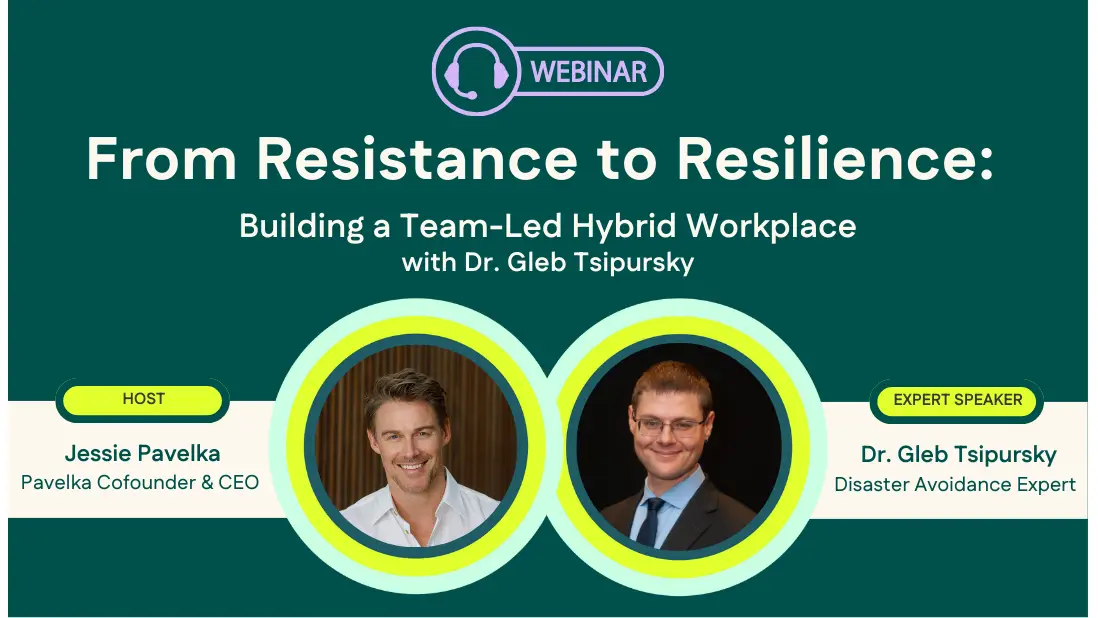From Resistance to Resilience: The Hybrid Playbook Every Leader Needs
Resilience is key when considering how to design a hybrid culture that actually supports your people (and leaves the chaos behind).
What if hybrid isn’t the problem?
It’s the opportunity we’re not using well enough to build resilience.
As more companies double down on return-to-office mandates, it’s easy to forget that hybrid work isn’t a compromise. When done right, it’s a catalyst for performance, connection, and yes, resilience.
But here’s the catch:
Hybrid only works when it’s thoughtfully designed.
Without clarity, trust, and structure, it turns into chaos—and everyone feels it.
This article is your evidence-based playbook for getting hybrid right, drawing on insights from our work and webinar series with behavioral science expert Dr. Gleb Tsipursky.
No one-size-fits-all rules. No “three days in, two days out” mandates. Just simple, science-backed strategies that create space for your people to thrive with resilience at the centre.
Why hybrid models break down
When hybrid fails, it’s not because people aren’t trying. It’s because the model they’re working in doesn’t work for them, lacking. Here’s what we see most often:
- Misaligned expectations: Leaders want in-person energy. Employees want flexibility. There’s a clear disconnect, which causes tension on both sides.
- Lack of autonomy: Policies are decided in the boardroom, not amongst the teams. Trust suffers as a result.
- Too much “always-on”: Without boundaries, hybrid becomes a 24/7 free-for-all, and burnout follows.
- No shared purpose: People come into the office “just because,” not for collaboration that matters.
These aren’t individual problems. They’re systemic design flaws affecting resilience.
The foundation of resilience is autonomy
Resilience doesn’t come from pushing your people harder. It comes from giving them more control over how they work best, especially in a hybrid setting.
According to behavioral science expert Dr. Gleb Tsipursky, autonomy is one of the three core psychological needs that drive motivation and engagement (alongside competence and connection). When autonomy is honoured, resilience is nurtured:
- Teams feel trusted and invested in their work
- Energy is directed toward outcomes, not logistics
- Stress decreases and wellbeing becomes more sustainable
“Resilient teams grow from a place of trust, when people are given the freedom to design how they work best, together.”
— Jessie Pavelka, CEO & Co-Founder
5 ways to build hybrid resilience (without the chaos)
Here’s your no-fluff playbook from our latest webinar, From Resistance to Resilience: Building a Team-Led Hybrid Workplace, hosted by our CEO, Jessie Pavelka with Dr. Gleb Tsipursky:
- Let teams design their rhythm
Instead of one blanket policy, empower teams to co-create their norms: when they meet, where they collaborate, and how they stay connected, developing resilience.
✅ Builds trust
✅ Drives engagement
✅ Reduces resistance
- Define the “why” behind in-office time
If you’re asking people to come in, make it count. Are we brainstorming? Building culture? Onboarding new hires?
Purposeful presence > performative presence.
- Set guardrails—not surveillance
Trust people to do their work, which naturally feeds into resilience. That doesn’t mean being hands-off; it means setting clear expectations without micromanaging how or where work happens.
- Normalize recovery
In hybrid, work can creep into every corner of life. Leaders must model and encourage downtime, boundaries, and non-linear schedules.
Wellbeing isn’t a perk—it’s a key component of performance.
- Revisit and refine
Hybrid isn’t “set it and forget it.” Check in with teams regularly. What’s working? What’s wearing them down? Use feedback loops to adapt as needs evolve, building resilience.
Out now: The full webinar
Want to see this playbook in action?
Our webinar From Resistance to Resilience has officially launched, and it’s packed with frameworks, facilitation tools, and real-life strategies for making hybrid actually work for your people.
Watch the Webinar Here:
Final Thought
You don’t have to overhaul everything.
Start with one team. One rhythm. One conversation, and build resilience step by step.
When hybrid is designed for people—not policies—resilience follows.
____________________________________________
Sources and Further Reading
Autonomy and Intentionality Offer Key Competitive Advantage


